 All streets is a project by Ben Fry which maps all 26 million roads to the lower 48 states in the USA. No other features were added yet as Ben notes cities mountains and other geographical features emerge from the absense of roads or their patterns as are diverted around these unseen obstacles.
All streets is a project by Ben Fry which maps all 26 million roads to the lower 48 states in the USA. No other features were added yet as Ben notes cities mountains and other geographical features emerge from the absense of roads or their patterns as are diverted around these unseen obstacles.
Wednesday, November 12, 2008
018. All Streets
 All streets is a project by Ben Fry which maps all 26 million roads to the lower 48 states in the USA. No other features were added yet as Ben notes cities mountains and other geographical features emerge from the absense of roads or their patterns as are diverted around these unseen obstacles.
All streets is a project by Ben Fry which maps all 26 million roads to the lower 48 states in the USA. No other features were added yet as Ben notes cities mountains and other geographical features emerge from the absense of roads or their patterns as are diverted around these unseen obstacles.
Monday, October 20, 2008
017. Revolutionary Minds.
From a recent edition of Seed Magazine, Revolutionary Minds explores the work of several designers and architects working with a very generative and organic approach to creativity. Embedded below are clips featuring Skylar Tibbits and Aranda Lasch.


Tuesday, July 22, 2008
016. Reimagining Robin Hood Gardens
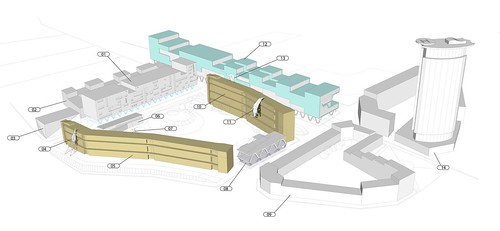

Here is our entry for the recent competition for Robin Hood Gardens as run by Building Design.
Our proposal for the recent competition for Robin Hood Gardens as run by Building Design, focused on restoring Robin Hood Gardens at the heart of a dense urban realm for Blackwall Reach.
Robin Hood Gardens' high rise but low density development, with a unique green open space at its centre, forms the centrepiece for a fundamental urban redevelopment that focuses on public space and interaction.
Thus proposal attempts an intensification of the urban field around Robin Hood Gardens, re-establishing prior street patterns and creating new ones through a series of urban interventions, exploring both existing archetypes of urban form and also new urban prototypes.
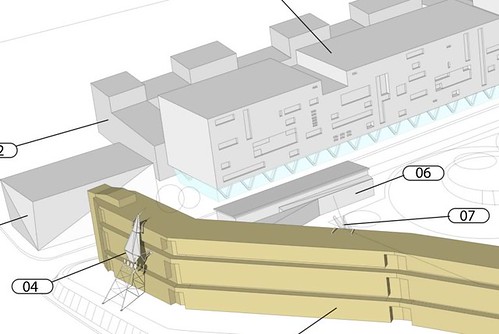
Touching lightly on the facade of RHG, 4 mobile, kinetic parasitic structures provide security, lighting and telecommunications, an exo-refit for RHG. Mobile, robotic units, they move along the articulated facade of RHG.
As can be seen on the BD website, most of the shortlisted entries focussed on new approaches to the two blocks themselves, with numerous protrusions, and slicing into the building, and across the estate.
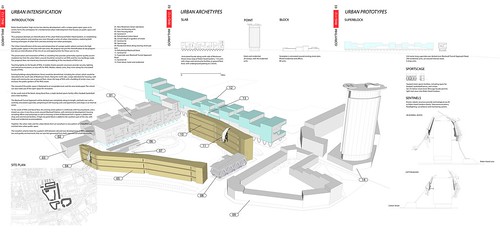
Labels:
architecture,
Brutalism,
competition,
Robin Hood Gardens
Tuesday, June 24, 2008
015. A Night at the Opera
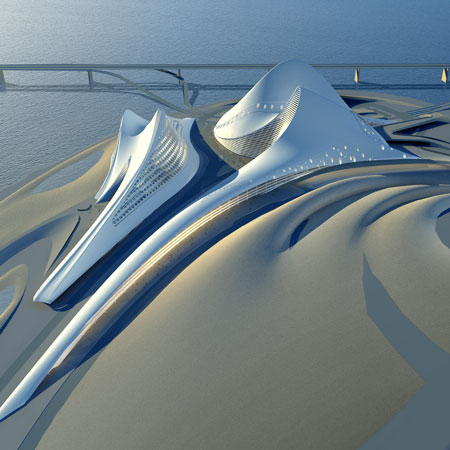
Hadid's Opera House in Dubai is the first true architecture of the 21st Century. Digital. Sleek. Perfect. So why build it?
That most celebrated of building types, the Opera House has given us culture barns such as La Scala in Milan, the Beaux Art Paris Opera, and of course Utzon's masterpiece in Sydney. If Sydney Opera House was the iconic building of the 20th Century, perhaps Hadid's Dubai Opera House might be the definitive work of this.
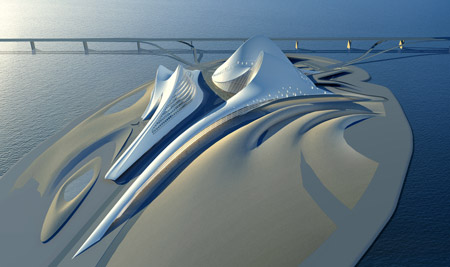
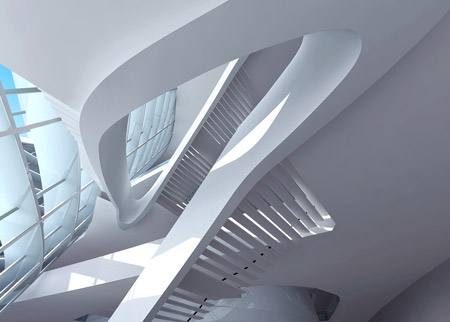
It is the culimination of the proceses her practice has been exploring throgh projects such as the Phaeno Centre, the BMW building, and the Centre for Contemporary Arts in Rome. Traditional architectural elements are dissolved, the arrangement of spaces determined by the composition. Form follows function is an antiquated concept these days, but here function is a mere conceit. Form follows more form.
Form rides everything is where parametric modelling leads - an aesthetic darwinism of evolved appearances. You can see it in almost every project to come form the DRL at the AA, the farm team for Zaha Hadid Architects, and where Patrik Schumacher teaches.
With this project, walls and roof are united into a sleek 'hull', transformed by parametric process which warped slice and skew the form into a sensuous, sinuous form that rises and twists it's way across the dunes.
The sheer beauty of the renderings is breathtaking. I want to inhabit its spaces (virtually). I want to fly through it. I want to explore its surface, its textures and materials. But I have no intention of visiting it.
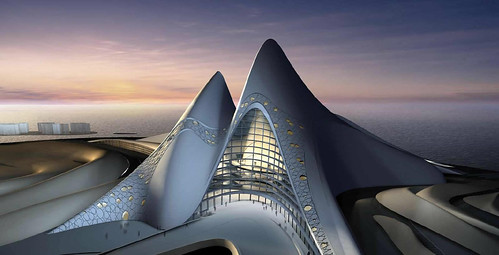
The only reason to build it is to prove it is buildable, that the building can capture the essence of the renderings.
But the reality will never live up to the beauty of the proposals. So why bother?
The future of architecture is not Dubai, but Dezeen.
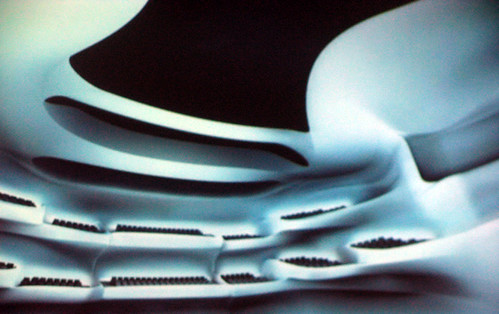
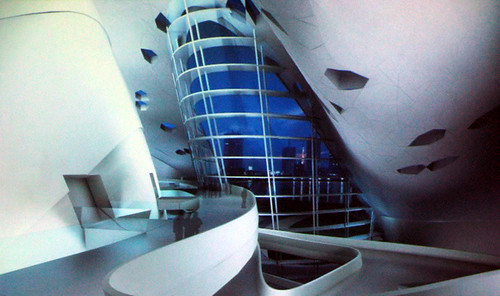

Friday, June 20, 2008
014. Meet the Starchitects

These fantastic caricatures, drawn by Kathryn Rathke, can be found in the latest issue of Intelligent Life magazine from The Economist. In the Summer 08 issue, you'll also find a great profile of Queen Zaha by Jonathan Meades.
I think these caricatures could become the definitive image of these architects, I especially like Nouvel's Dr Evil pose. Click on the thumbnails below for larger images.
 |  |  |  |  |
Friday, April 11, 2008
013. Gundam Architecture
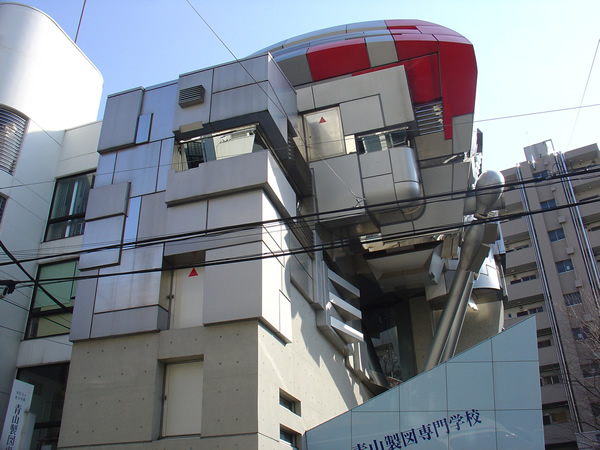
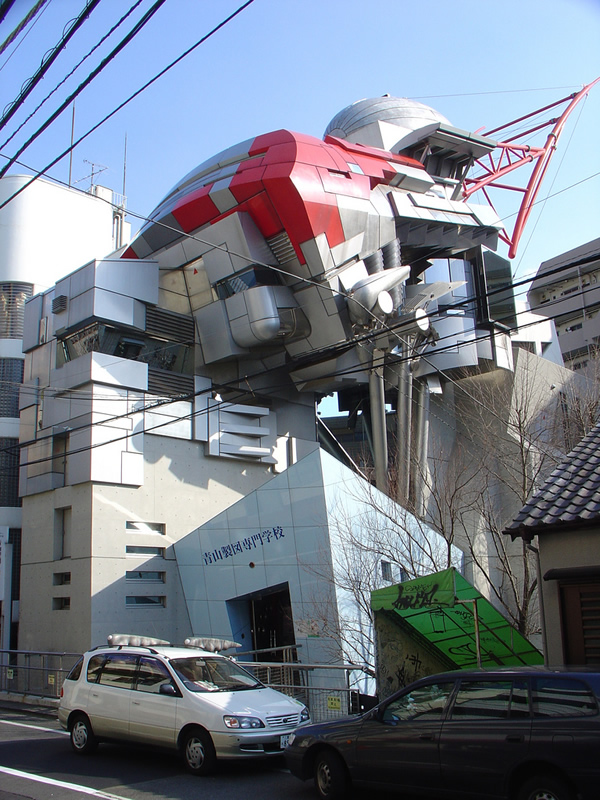

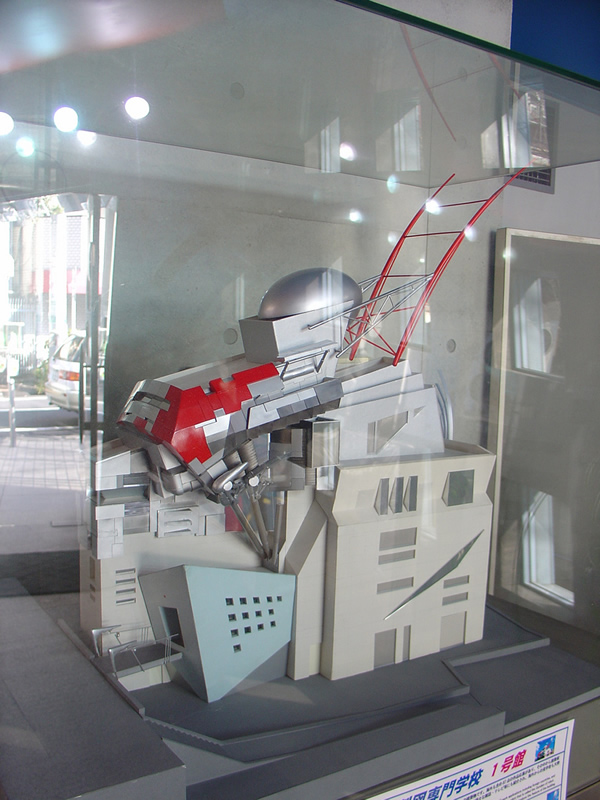
Here are some remarkable images of Aoyama Technical College, by Makoto Sei Watanabe, posted by Flickr user Viggo:
The building, in the Shibuya district of Tokyo, has been developed from a process of self-organisation in an attempt to define an emergent urban form for Tokyo:
"The self-organizing, organic system that emerges on this principle, however, is-like a natural phenomenon-not conscious. As long as it remains an unconscious principle, it is difficult to draw upon in creating, for example, some building."
"By extracting from the spontaneous workings of this principle those methods that we can consciously apply, it is possible that we might develop a conscious principle upon which to create a new architecture for the city. The Aoyama Technical College aims to discover such a principle for establishing a new order"
Elsewhere, we learn of a Japanese robotics expert, Takayuki Furuta, who wants to build a six-storey tall Gundam battle robot, and has costed it out at approx $742 million.
Tuesday, March 18, 2008
012. Surreal Madrid
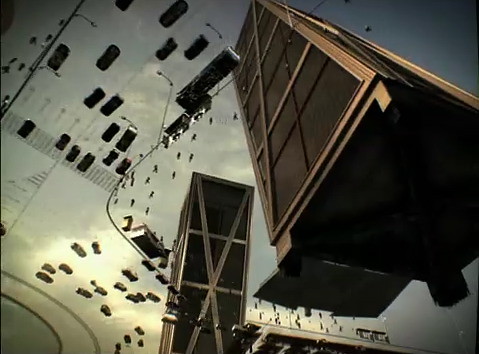
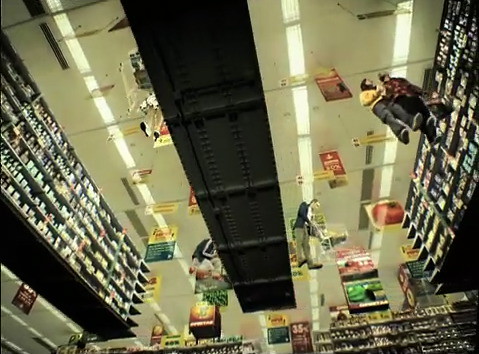

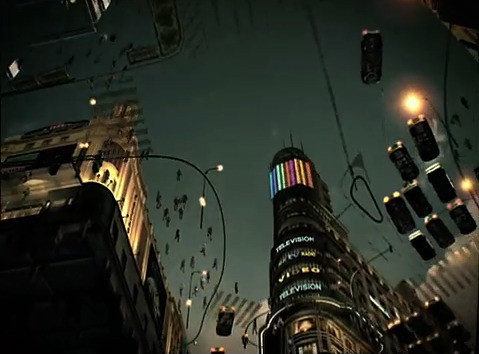
This advert for Madrid Metro presents a view of the city from below, the Spanish capital literally turned into a floating city, a worms-eye view of the world, suspended in a moment in time.
This video reminded me of the worms-eye axonometric drawigns that James Stirling was infamous for, a sadly underused representational technique in these days of 3D computer modelling. Alas there seems to be a distinct lack of these drawings available online - they are an exquisite way of capturing space.
Thursday, January 24, 2008
011. Songlines.
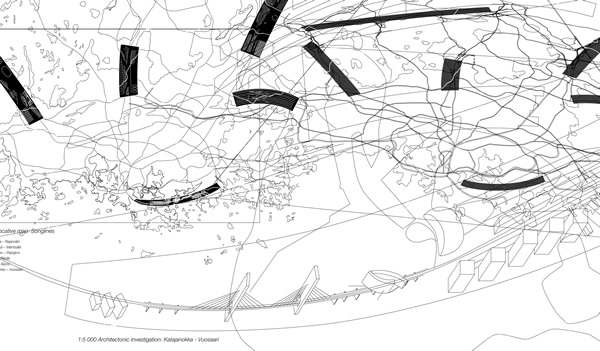

Here is the entry from Team Helsinki for the Helsinki 2050 competition, from which your humble SuperSpatial team was formed.
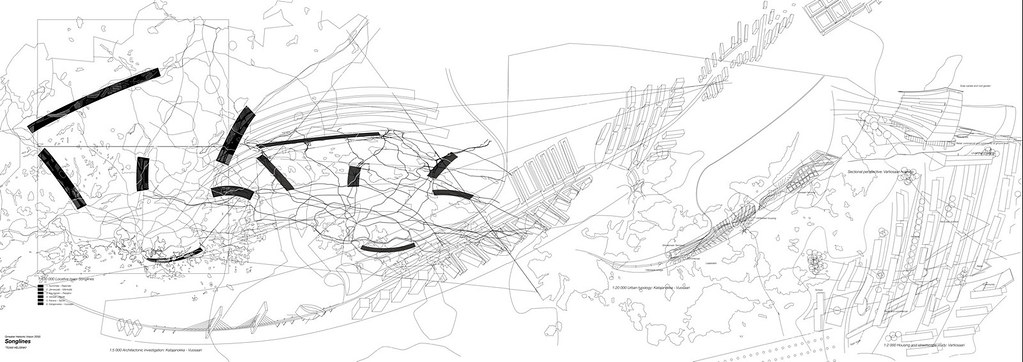
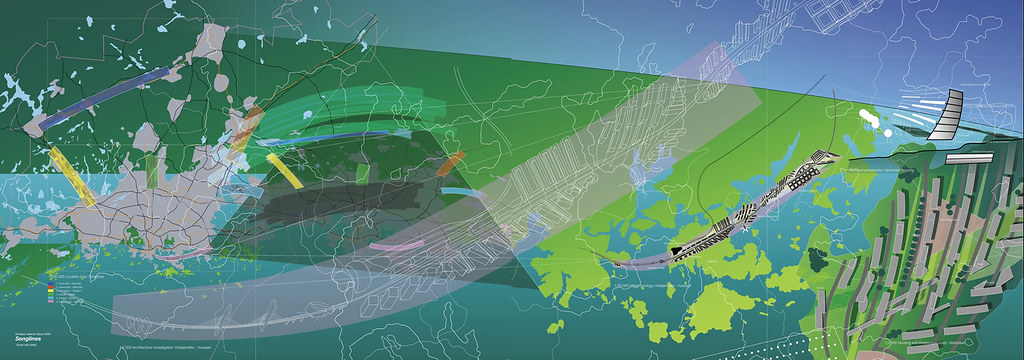
[click on the images for larger-scale versions]
Called Songlines, we sought to create 6 urban corridors connecting regions across Helsinki, attempting to create sustainable communities that subverted the normal urban-peripheral dualism of most concentratic city plan. This model, with it's Central Business District, cultural centre and radial hub-and-spoke transportation system seemed to us a 19th and 20th Century pattern that had little relevance for the citizens of mid-21st century Helsinki.
So we sought to create mini-decentralised cities, areas of urban intensification in linear suburbs, each of which could possess unique characteristics due to special planning, tax or other regulations. Thus the Vantaa – Riipilä corridor (or 'songline') might have tax relaxtions which would attract high-tech business start-ups, while the Järvenpää – Mäntsälä zone would be declared petroleum free zone.
Our proposal went into the most depth along the Katajanokka - Vuosaari corridor, which we envisaged as a gateway to the city, focussed around a high-speed Helsinki-St. Petersburg 'Shinkansen'. This area is ripe for development to help meet the requirement for the amount of new housing that a growing city like Helsinki would need by 2050, as set out in the brief, but rather than use the proposed metro line as the engine of development, a well planned shuttle tram service would be cheaper and more environmentally friendly.
The area was an opportunitity to explore a number of housing and mixed use typologies
Our entry was placed a lowly 58 (out of 109 accepted entries), with the jury finding "an ironically made (e.g. bioterrorism courses for a prospective Sipoo university and a Christiana-type community in Kauniainen), incomplete entry, nevertheless featuring beautifully presented documents."
However, we can be proud that we produce something with such a limited resource which contained the germ of some genuinely good ideas that sparked some interesting debate.
Download our detailed proposal for Katajanokka - Vuosaari.
Download detailed_proposal.pdf (49.6K)
Download our 'helsinki vision' document
Download helsinki_vision.pdf (81.9K)
Friday, January 18, 2008
010. Emeralds shimmer in Helsinki.
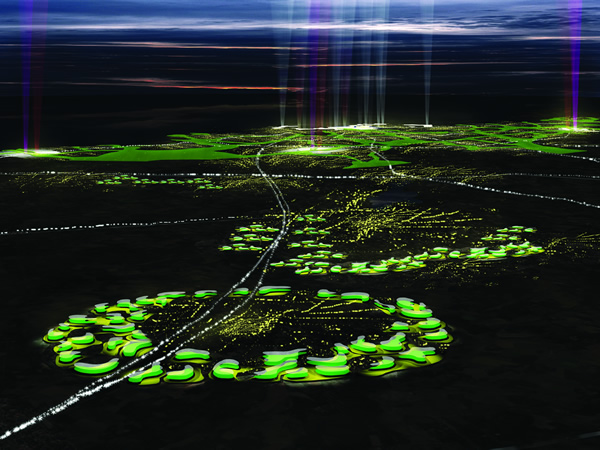
The recent Greater Helsinki Vision 2050 ideas competition drew a large number of entries, and was an extremely well run and judged concours. With over €250,000 on offer in total prizemoney, it attracted some very polished and professional entries.
You can download a document with a thorough overview of all the entries here.
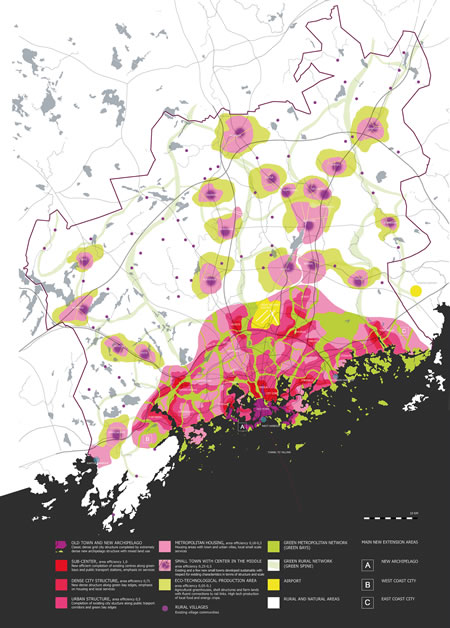

The winning entry, Emeralds, by WSP Finland is stunning. The basic concept of "green bays" of development form a urban tapestry which act as both a unifying element as well as a distinguishing feature. The rich, multi-disciplinary entry addresses issues that Helsinki will need to consider over the next 40 years social, spatial, transportation and infrastructure and presents a compelling, vivid, proposal - everything good architectural speculation should do.
TeamHelsinki, which both Lewis and Kosmograd were members of, managed to put an entry together, which while not matching the depth of thought and presentation quality of the top entries, nevertheless had some good ideas, and was a great way to stretch those flabby architectural muscles, so to speak.
As a whole, the Greater Helsinki Vision 2050 competition should serve as a benchmark for other architectural competitions to strive for.

Tuesday, January 15, 2008
009. Oslo Recoded

Oslo following many cities worldwide over the past two decades is redeveloping its waterfront, and rethinking the way it approaches the water, now that these areas are required less and less for industrial use. The area of Bjørvika, a no mans land behind Oslo's Central station is being redeveloped into a new city district. Barcode is the name of this small area of mainly office redevelopment, part of a greater regeneration of Oslo waterfront. Its a tight space for offices with Oslos planning limitations deliberatly changed for the area. Higher buildings are allowed, the tallest in Norway, and the planning law was aesthetically subverted too.
'This is the first plan in Norway where rules are not drawn up regarding each plot, but instead there are rules for how plots within a particular area should be designed in relation to each other. If we design a house with a flat roof, then the next house may not have a flat roof. If we design a glass building, the next house must use a different material.'

The Barcode masterplan was conceived by MVRDV in partnership with a-lab and Dark. Its interesting because the masterplan imposes change between each new building without defining a particular style, only that it be different from the last. It also uses a modern 'valueless' iconography of the barcode to impose some order instead of an architectural aesthetic a classic reworking of an MVRDV theme. I like that it reverses the normal planning rules and imposes non conformity with the neighbouring buildings to try to create a sense of urban life.

The first building in this new area designed by a-lab is the PWC building. Its nothing really special, and I'm wondering if there will really be any exciting Architecture in a relatively bland looking development so far, but the idea of a planning regime that imposes change but not style is really attractive.
Some more links:
Arkiteknytt (Norweigian Architects website)
OSU (The developer of Bjørvika)
Skyscrapercity (a thread with some great images of new developments generally in Oslo)
Subscribe to:
Posts (Atom)
